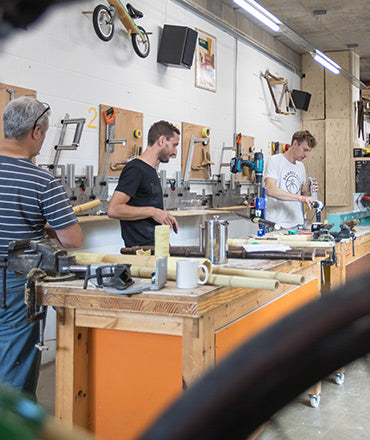How to Grow, Harvest And Dry Bamboo
How to grow bamboo
Bamboo can be grown anywhere in the world. It requires minimal care and maintenance, and is a sustainable material. It can grow in most soil types and thrives in moist, well-drained soil in a sheltered, sunny spot. It will not cope well in constant wet, boggy conditions or extremely dry weather. Here are our top tips on growing your own bamboo:






- There are two main types of bamboo plants; clump-forming bamboo and running bamboo (the latter will produce long underground stems that pop up away from the main plant and will spread anywhere if it is not contained!)
- The easiest way to grow bamboo is in a container, a trench or in the ground
- In a container is the quickest and easiest method to grow bamboo. Sink a large container into the ground, leaving the top lid over the surface of the soil which will ensure your bamboo only grows to the size of the container and not spread beyond
- In a trench is the best method for creating a hedge or screen of bamboo. Dig a trench between 2-4 feet deep, curving at each end into a C shape. Line the trench with an impenetrable material leaving about 3 inches over the surface of the soil, and fill the trench compacting the soil well. It is then ready for the bamboo to be planted
- In the ground is the best option if you are happy for it to spread. Dig a hole twice the size of the root mass, mix some compost into the base of the hole before placing the bamboo in the ground so that the root mass sits level with the ground surface, mix with more compost and then fill and water
- Bamboo takes approximately three years to get established
- One established, new shoots that emerge in Spring will continue to get bigger and more numerous from year to year as it moves towards maturity
- It is best to fertilise bamboo in early spring and mid to late summer
- Keep it healthy by regularly removing dead matter from the canes and around the base, which will help maintain good air circulation
How to harvest bamboo
Harvest bamboo shoots in the spring when the plants first begin to grow, cutting those that are about 6 inches high at ground level with a sharp knife. For workable bamboo, it is harvested from 2-3 years through to 5-7 years, depending on the species:
- Young bamboo (0-2 years) can be recognised by the shiny green colour and presence of culm sheaths. Older bamboo will change from a shiny green to a grey/dark green colour, and the traditional white bands at each node will have almost disappeared or been replaced with barely perceptible grey bands, showing evidence of its maturity and timely selection for harvest
- Once bamboo is older than 7 years, it starts to dry and gradually loses its mechanical properties
- It is best to harvest bamboo at the end of the rainy season, beginning of the dry season; as bamboo contains large amounts of starch (sugars) which are the principle nutrients for parasites, borers ad fungi, and dry season is when sugar content is lowest
- Cut bamboo just above the first or second node above ground level, with a machete or saw
- Do not drag cut bamboo along the ground, as it will damage the outer layers
- Do not throw bamboo on hard ground, as this can induce cracks along the lengths
How to dry bamboo
Drying bamboo requires more time than wood of a similar density, because it possesses hygroscopic materials (a compound that easily absorbs moisture) and may contain 50-60% moisture content, depending on the species. The most common way to dry bamboo for commercial purposes is “air drying”, once the poles have been harvested and chemically treated, which takes between 6 and 12 weeks:
- The poles should be stored under cover, away from direct soil contact to prevent fungal or insect attacks, and avoid the humidity of the soil affecting the drying process
- Stack poles vertically as this leads to faster drying, but ensure there is good support to prevent the poles bending
- Avoid rapid changes in moisture contact, as this can cause cracks in the bamboo poles
- Provide good ventilation and circulation of air
- For uniform drying, the bamboo should be rotated every 15 days
Other methods include post-harvesting transpiration, often used by indigenous communities and takes place on a plantation. It not only dries the bamboo but also prevents insect infestation, by placing the freshly cut poles upright on a stone and leaning them against another bamboo tree with the branches and leaves attached for 3 weeks, during which the bamboo stems lose their humidity and the leaves true. You can also use a kiln oven for drying, however high temperatures can increase the chance of bamboo cracking and collapsing. Although split bamboos can easily be kiln dried. Harvested bamboo can also be stored in water if you need to maintain its pliability, or if it needs to be processed in its “green” condition.


